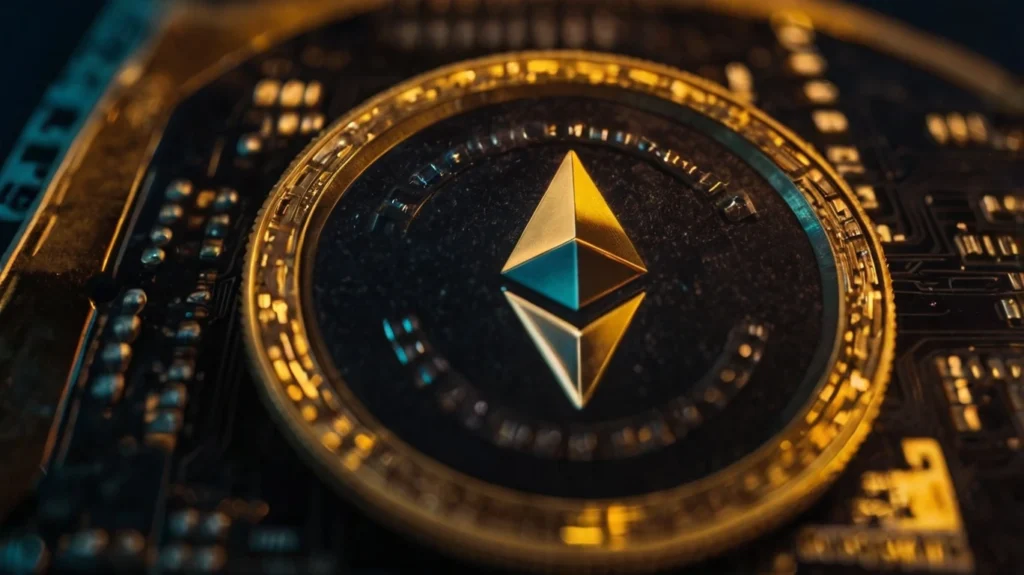
Gas fees are one of the most talked-about aspects of using Ethereum. Simply put, they are the transaction costs users pay to perform actions on the Ethereum blockchain, like sending tokens, interacting with decentralized applications (dApps), or buying NFTs. Each transaction requires computational power from the network, and gas fees incentivize validators (Ethereum’s network participants) to process these actions. The higher the fee you’re willing to pay, the faster your transaction may be processed.
High gas fees have become a common frustration, especially during peak times when network demand surges, driving up the cost to perform even simple transactions. These fees fluctuate based on network traffic and transaction complexity, which can make Ethereum less accessible to everyday users. Thankfully, there are evolving solutions to this problem. Layer-2 technologies like Optimism and zkSync are gaining traction, aiming to offer faster, cheaper transactions by handling some processes off the main blockchain and reducing gas fees.
In this article, we’ll dive into the details of gas fees, why they’re essential yet costly, and practical strategies to reduce them. We’ll cover various ways to minimize costs, from selecting the best transaction times to using Layer-2 solutions. Whether you’re new to crypto or exploring Ethereum deeply, this guide will give you a complete picture of Ethereum gas fees and how to navigate them.
What Are Ethereum Gas Fees?
Gas fees are the “fuel” that keeps Ethereum running. Every time you perform a transaction on Ethereum—such as sending Ether (Ethereum’s native currency), executing a smart contract, or buying an NFT—you must pay a transaction fee called a gas fee. These fees compensate Ethereum’s network participants, known as miners (now validators in Ethereum 2.0), for processing and validating your transaction. Think of gas as a toll: it’s a cost to enter the highway of Ethereum’s network.
How Does Gas Work?
The amount of gas required for a transaction depends on the complexity of the action. For example:
- Basic Transactions: Simple tasks, like sending Ether from one wallet to another, require minimal gas.
- Smart Contracts: Complex actions, such as those involving smart contracts or DeFi transactions, require more gas due to the multiple steps and computations involved.
Gas fees are denominated in “gwei,” a unit of Ether. Just as there are 100 cents in a dollar, there are 1 billion gwei in one Ether. The total gas fee is calculated based on the gas limit (the maximum amount you’re willing to spend) and the current gas price.
Why Are Ethereum Gas Fees So High?
Ethereum’s popularity has underscored the need for scalable solutions that address the growing costs and delays associated with gas fees. As more users join the network, these fees have become a persistent issue, limiting Ethereum’s potential for widespread adoption. For instance, smaller DeFi transactions and NFT purchases can be priced out entirely when gas fees surge, making Ethereum’s network feel inaccessible to casual users and those with limited budgets. This has sparked demand for efficient, cost-effective methods to make Ethereum more user-friendly and affordable.

The implementation of Layer-2 solutions, such as Optimistic Rollups and zkSync, represents a significant step in that direction by processing transactions on secondary layers, alleviating the pressure on Ethereum’s main blockchain. Meanwhile, the long-awaited Ethereum 2.0 upgrade, which shifts the network to a proof-of-stake consensus, is designed to improve transaction throughput and reduce environmental impact, aiming to make high gas fees a thing of the past. Together, these advancements highlight Ethereum’s commitment to evolving with its users’ needs, paving the way for a more sustainable and accessible blockchain ecosystem.
Key Factors Behind High Gas Fees
- Network Congestion: Ethereum’s main chain can only process about 15–30 transactions per second. When activity surges, so do gas prices, as users compete to have their transactions processed first.
- Auction Model: Ethereum uses a “first-price auction” for gas. Essentially, users bid for their transaction to be included in the next block by setting a high gas price, driving prices up during peak times.
- Rising Demand for DeFi and NFTs: Certain high-profile events—like NFT drops or DeFi project launches—often cause huge gas spikes. For example, during the launch of projects like Bored Ape Yacht Club NFTs, fees skyrocketed as thousands tried to purchase NFTs simultaneously, creating a bottleneck in the network.
How Can You Reduce or Avoid High Gas Fees?
High gas fees can make it impractical to use Ethereum for small or frequent transactions. Luckily, there are ways to reduce these costs:
1. Timing Your Transactions
Gas prices fluctuate throughout the day. By transacting during off-peak hours—usually early in the morning or late at night—you can often avoid the highest fees.
2. Using Layer-2 Solutions
Layer-2 solutions are networks built on top of Ethereum (the main or “Layer-1” blockchain). They handle transactions separately from Ethereum’s main chain and then report back, significantly increasing the network’s capacity and lowering costs. Popular Layer-2 solutions include:
- Optimism: Optimistic Rollups bundle multiple transactions together and only verify them if disputed, making them faster and cheaper.
- zkSync: Zero-Knowledge (zk) Rollups batch transactions with cryptographic proofs for instant verification, offering fast and low-cost transactions.
3. Switching to Cheaper Blockchains
Some users choose alternative blockchains like Polygon, Avalanche, or Solana, which often have lower fees and faster processing times. Many dApps and exchanges now operate across multiple blockchains, allowing you to select one that best suits your budget and needs.
4. Setting Custom Gas Fees
Most wallets allow you to set custom gas fees. By setting a fee that’s lower than the current average, you can save on costs, though this may delay your transaction if other users are paying higher fees.
5. Gas Tracking Tools
Tools like Etherscan and GasNow offer real-time data on gas prices. Using these tools can help you predict the best time to execute a transaction, based on current network activity.
Recent News on Gas Fees: Ethereum’s Push for Scalability
Ethereum’s high gas fees have been a focal point for improvement as the platform works toward broader accessibility. The 2022 transition to Ethereum 2.0 and Proof of Stake (PoS) was a major step aimed at making Ethereum more efficient. Although this upgrade significantly reduced Ethereum’s environmental impact and increased security, gas fees remain a challenge due to persistent demand.
To address this, developers are working on solutions to further reduce fees:
- Sharding: Part of the Ethereum 2.0 roadmap, sharding will divide the Ethereum blockchain into multiple “shards” to spread out the network’s load. This approach will increase capacity and reduce congestion, ultimately lowering gas fees.
- EIP-1559: A notable update included in Ethereum’s London Hard Fork, EIP-1559 introduced a “base fee” system that makes gas fees more predictable and reduces volatility. It also burns a portion of each transaction fee, reducing the total supply of Ether over time.
These updates have been crucial in Ethereum’s journey toward scalability and affordability, but Layer-2 solutions remain essential for significant, immediate impact.
Why Layer-2 Solutions Are Vital for Lowering Fees
Layer-2 solutions like Optimism and zkSync are leading the charge in reducing gas fees. By processing transactions outside Ethereum’s main chain, these solutions prevent congestion and reduce fees for users on the network.
- Optimistic Rollups assume transactions are valid unless proven otherwise, only verifying transactions if a dispute arises. This reduces the time and computational power needed for each transaction, lowering costs.
- zk-Rollups use cryptographic “zero-knowledge” proofs, allowing thousands of transactions to be verified at once with minimal data on the main Ethereum chain.
As these Layer-2 solutions gain traction, Ethereum users can expect faster, cheaper transactions without sacrificing security. For DeFi platforms, gaming dApps, and NFT marketplaces, Layer-2 solutions are making it possible to reach mainstream adoption.
The Future of Gas Fees on Ethereum
Looking ahead, gas fees are likely to remain a point of focus for Ethereum developers, as they continue to push for scalability and accessibility. In addition to Layer-2 solutions and sharding, Ethereum is moving toward a multi-chain ecosystem, where users can move assets and data seamlessly across different blockchains.
As Ethereum scales and evolves, gas fees will become more manageable, allowing even small, everyday transactions to take place on the network affordably.
Final Thoughts: Making Ethereum Accessible for All
Gas fees are an essential part of Ethereum, incentivizing validators to process transactions and secure the network. However, high fees can be a barrier to mainstream adoption, especially for users trying to make small or frequent transactions. Fortunately, by timing transactions, using Layer-2 solutions, and leveraging gas tracking tools, you can lower these costs significantly.
With advancements in Layer-2 technologies, Ethereum 2.0 updates, and future innovations like sharding, Ethereum’s vision of a truly decentralized, accessible network is closer than ever. Whether you’re a first-time user or a crypto veteran, understanding gas fees and using available tools will help you make the most of Ethereum’s powerful ecosystem—without breaking the bank.
Ethereum’s future is bright, and as gas fees continue to stabilize, the platform will become an even more attractive space for users, developers, and researchers alike.
Must Read : Why AMM 2.0 is Essential

